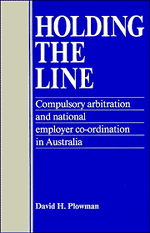Book contents
- Frontmatter
- Contents
- List of tables and figures
- List of abbreviations
- Acknowledgements
- Introduction
- Dedication
- 1 Industrial legislation and the rise of permanent employer associations 1890–1906
- 2 The Higgins era 1907–1920
- 3 Rival shops 1921–1929
- 4 Depression and recovery 1930–1939
- 5 War and government executive action 1940–1949
- 6 Consolidation 1950–1959
- 7 The National Employers' Associations 1960–1972
- 8 Confederation 1973–1988
- 9 Models of national employer co-ordination
- Appendices
- Bibliography
- Records of organisations
- Index
- Frontmatter
- Contents
- List of tables and figures
- List of abbreviations
- Acknowledgements
- Introduction
- Dedication
- 1 Industrial legislation and the rise of permanent employer associations 1890–1906
- 2 The Higgins era 1907–1920
- 3 Rival shops 1921–1929
- 4 Depression and recovery 1930–1939
- 5 War and government executive action 1940–1949
- 6 Consolidation 1950–1959
- 7 The National Employers' Associations 1960–1972
- 8 Confederation 1973–1988
- 9 Models of national employer co-ordination
- Appendices
- Bibliography
- Records of organisations
- Index
Summary
This study examines the factors that have led to employer associations forming co-ordinating machinery and the rationale for the particular form of combination used at different points in time. Historically, three factors have been important in stimulating inter-association co-ordinating mechanisms. The first has been the need to counteract union activities. This factor was of prime importance in the first decade reviewed in this study. The second factor was the opposition of many employers to the imposition of compulsory arbitration and the need for effective political lobbying machinery to oppose arbitration legislation. Unity on this score was hampered by manufacturers' support for protection, even ‘New Protection’ with its implied acceptance of arbitration. Following the introduction of arbitration and legislation enabling unions to aggregate claims and mount ‘test cases’, employers found it necessary to co-ordinate their approach in such cases to ensure their submissions were not at cross-purposes with each other. This third factor continues to provide for a symbiotic relationship between national employers and arbitration machinery.
- Type
- Chapter
- Information
- Holding the LineCompulsory Arbitration and National Employer Co-ordination in Australia, pp. xiii - xviiiPublisher: Cambridge University PressPrint publication year: 1989



